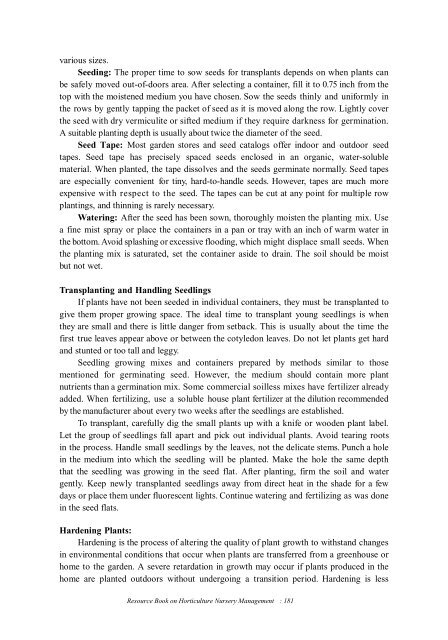Resource Book on Horticulture Nursery Management
Resource Book on Horticulture Nursery Management
Resource Book on Horticulture Nursery Management
Create successful ePaper yourself
Turn your PDF publications into a flip-book with our unique Google optimized e-Paper software.
various sizes.<br />
Seeding: The proper time to sow seeds for transplants depends <strong>on</strong> when plants can<br />
be safely moved out-of-doors area. After selecting a c<strong>on</strong>tainer, fill it to 0.75 inch from the<br />
top with the moistened medium you have chosen. Sow the seeds thinly and uniformly in<br />
the rows by gently tapping the packet of seed as it is moved al<strong>on</strong>g the row. Lightly cover<br />
the seed with dry vermiculite or sifted medium if they require darkness for germinati<strong>on</strong>.<br />
A suitable planting depth is usually about twice the diameter of the seed.<br />
Seed Tape: Most garden stores and seed catalogs offer indoor and outdoor seed<br />
tapes. Seed tape has precisely spaced seeds enclosed in an organic, water-soluble<br />
material. When planted, the tape dissolves and the seeds germinate normally. Seed tapes<br />
are especially c<strong>on</strong>venient for tiny, hard-to-handle seeds. However, tapes are much more<br />
expensive with respect to the seed. The tapes can be cut at any point for multiple row<br />
plantings, and thinning is rarely necessary.<br />
Watering: After the seed has been sown, thoroughly moisten the planting mix. Use<br />
a fine mist spray or place the c<strong>on</strong>tainers in a pan or tray with an inch of warm water in<br />
the bottom. Avoid splashing or excessive flooding, which might displace small seeds. When<br />
the planting mix is saturated, set the c<strong>on</strong>tainer aside to drain. The soil should be moist<br />
but not wet.<br />
Transplanting and Handling Seedlings<br />
If plants have not been seeded in individual c<strong>on</strong>tainers, they must be transplanted to<br />
give them proper growing space. The ideal time to transplant young seedlings is when<br />
they are small and there is little danger from setback. This is usually about the time the<br />
first true leaves appear above or between the cotyled<strong>on</strong> leaves. Do not let plants get hard<br />
and stunted or too tall and leggy.<br />
Seedling growing mixes and c<strong>on</strong>tainers prepared by methods similar to those<br />
menti<strong>on</strong>ed for germinating seed. However, the medium should c<strong>on</strong>tain more plant<br />
nutrients than a germinati<strong>on</strong> mix. Some commercial soilless mixes have fertilizer already<br />
added. When fertilizing, use a soluble house plant fertilizer at the diluti<strong>on</strong> recommended<br />
by the manufacturer about every two weeks after the seedlings are established.<br />
To transplant, carefully dig the small plants up with a knife or wooden plant label.<br />
Let the group of seedlings fall apart and pick out individual plants. Avoid tearing roots<br />
in the process. Handle small seedlings by the leaves, not the delicate stems. Punch a hole<br />
in the medium into which the seedling will be planted. Make the hole the same depth<br />
that the seedling was growing in the seed flat. After planting, firm the soil and water<br />
gently. Keep newly transplanted seedlings away from direct heat in the shade for a few<br />
days or place them under fluorescent lights. C<strong>on</strong>tinue watering and fertilizing as was d<strong>on</strong>e<br />
in the seed flats.<br />
Hardening Plants:<br />
Hardening is the process of altering the quality of plant growth to withstand changes<br />
in envir<strong>on</strong>mental c<strong>on</strong>diti<strong>on</strong>s that occur when plants are transferred from a greenhouse or<br />
home to the garden. A severe retardati<strong>on</strong> in growth may occur if plants produced in the<br />
home are planted outdoors without undergoing a transiti<strong>on</strong> period. Hardening is less<br />
<str<strong>on</strong>g>Resource</str<strong>on</strong>g> <str<strong>on</strong>g>Book</str<strong>on</strong>g> <strong>on</strong> <strong>Horticulture</strong> <strong>Nursery</strong> <strong>Management</strong> : 181











